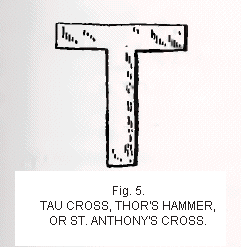

The Swastika
Definitions, Description & Origin
Some foreign authors have called it Thor's hammer, or Thor's hammer-mark, but the correctness of this has been disputed. (1) Waring, in his work, "Ceramic Art in Remote Ages," (2) says:
The Swastika used to be vulgarly called in Scandinavia the hammer of Thor, and Thor's hammer-mark, or the hammer-mark, but this name properly belongs to the mark
Ludwig Müller gives it as his opinion that the Swastika has no connection with the Thor hammer. The best Scandinavian authors report the "Thor hammer" to be the same as the Greek tau (fig.5),
 the
same form as the Roman and English capital T. The Scandinavian name is
Mjolnir, the crusher or mallet.
the
same form as the Roman and English capital T. The Scandinavian name is
Mjolnir, the crusher or mallet.The Greek, Latin, and Tau crosses are represented in Egyptian hieroglyphics by a hammer or mallet, giving the idea of crushing, pounding, or striking, and so an instrument of justice, an avenger of wrong, (3) hence standing for Horus and other gods. (4) Similar symbolic meanings have been given to these crosses in ancient classic countries of the Orient. (5)
SYMBOLISM AND INTERPRETATION.
Many theories have been presented concerning the symbolism of the Swastika, its relation to ancient deities and its representation of certain qualities. In the estimation of certain writers it has been respectively the emblem of Zeus, of Baal, of the sun, of the sun-god, of the sun-chariot of Agni the fire-god, of Indra the rain-god, of the sky, the sky-god, and finally the deity of all deities the great God, the Maker and Ruler of the Universe. It has also been held to symbolize light or the god of light, of the forked lightning, and of water. It is believed by some to have been the oldest Aryan symbol. In the estimation of others it represents Brahma, Vishnu, and Siva, Creator, Preserver, Destroyer.
ENDNOTES:
1. Stephens, "Old Northern Runic Monuments," part ii, p.509; Ludwig Müller, quoted on p. 778 of this paper; Goblet d'Alviella, "La Migration des Symboles,"
p. 45; Haddon, "Evolution in Art," p. 288. [Back]
2. Page 12. [Back]
3. "La Migration des Symboles," pp.21,22. [Back]
4. "le Culte de al Croix avant Jesus-Christ," in the Correspondant, October 25,1889, and in Science Catholique, February 15,1890, p. 163 [Back]
5. Same authorities. [Back]
<< Previous Page Next Page >>
© 2004-2007 Northvegr.
Most of the material on this site is in the public domain. However, many people have worked very hard to bring these texts to you so if you do use the work, we would appreciate it if you could give credit to both the Northvegr site and to the individuals who worked to bring you these texts. A small number of texts are copyrighted and cannot be used without the author's permission. Any text that is copyrighted will have a clear notation of such on the main index page for that text. Inquiries can be sent to info@northvegr.org. Northvegr™ and the Northvegr symbol are trademarks and service marks of the Northvegr Foundation.

|